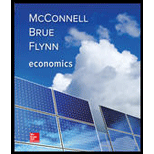
Economics (Irwin Economics)
21st Edition
ISBN: 9781259723223
Author: Campbell R. McConnell, Stanley L. Brue, Sean Masaki Flynn Dr.
Publisher: McGraw-Hill Education
expand_more
expand_more
format_list_bulleted
Question
Chapter 41, Problem 10RQ
To determine
The impact of the continuous trade deficit of the US.
Expert Solution & Answer
Want to see the full answer?
Check out a sample textbook solution
Students have asked these similar questions
this question has three questions . What proportion of this country’s total gross capital formation (or investment) can be financed from national savings, and what part must be financed from external resources? What are the various forms these external resources could take? show in graph how the current account got a deficit of 12% GDP and the budget deficit of 3%.
Suppose a country has a large current account deficit (in the vicinity of 12% of GDP). It has a gross capital formation rate of 28% of GDP. The country has an overall budget deficit of 3% of GDP. The share of Household and NPISHs Final Consumption Expenditure is 68% of GDP and that of General Government Final Consumption Expenditure is 12%. What proportion of this country’s total gross capital formation (or investment) can be financed from national savings and what part must be financed from external resources? What are the various forms these external resources could take?
Suppose that Argentina's dollar-denominated external assets and liabilities are $10 billion and $100 billion, respectively, and its Argentine peso-denominated external assets are 70 billion pesos (P) and peso-denominated external liabilities are 50 billion pesos (P). Suppose further that Argentina fixes its exchange rate at P1.5 = $US1.
a) What is the peso value of Argentina's total external wealth? Is it a net debtor or creditor?
b) Suppose that Argentina changes its exchange rate to P2.3 = $US1. How does the external wealth of Argentina change when this occurs?
8. Suppose that last year, the nominal exchange rate between the Japanese yen and the British pound was ¥150.0 per £1.0, one unit of Japanese output cost ¥1300, and one unit of British output cost £8.0.a. What was the real exchange rate between the U.K. and Japan last year, expressed as the cost of British output (i.e. – the quantity of Japanese output that exchanges for 1 unit of British output)? In which country were goods more expensive last year?
Chapter 41 Solutions
Economics (Irwin Economics)
Ch. 41.1 - Prob. 1QQCh. 41.1 - Prob. 2QQCh. 41.1 - Prob. 3QQCh. 41.1 - Prob. 4QQCh. 41.A - Prob. 1ADQCh. 41.A - Prob. 1ARQCh. 41.A - Prob. 1APCh. 41 - Prob. 1DQCh. 41 - Prob. 2DQCh. 41 - Prob. 3DQ
Ch. 41 - Prob. 4DQCh. 41 - Prob. 5DQCh. 41 - Prob. 6DQCh. 41 - Prob. 7DQCh. 41 - Prob. 8DQCh. 41 - Prob. 9DQCh. 41 - Prob. 10DQCh. 41 - Prob. 11DQCh. 41 - Prob. 1RQCh. 41 - Prob. 2RQCh. 41 - Prob. 3RQCh. 41 - Prob. 4RQCh. 41 - Prob. 5RQCh. 41 - Prob. 6RQCh. 41 - Prob. 7RQCh. 41 - Prob. 8RQCh. 41 - Prob. 9RQCh. 41 - Prob. 10RQCh. 41 - Prob. 1PCh. 41 - Prob. 2PCh. 41 - Prob. 3PCh. 41 - Prob. 4PCh. 41 - Prob. 5P
Knowledge Booster
Similar questions
- How did large trade deficits hurt the East Asian countries in the mid 1980s? (Recall that trade deficits are equivalent to inflows of financial capital from abroad.)arrow_forwardAssume the value of a country's currency is 1 when the price level is 1.2. Instructions: Enter your answers rounded to 2 decimal places. If you are entering any negative numbers be sure to include a negative sign (−) in front of those numbers. If the price level changes to 1.4, by how much in percentage terms will the value of the country's currency change? percent Now assume that the value of the country's currency is equal to 1 when the price level is 2. If the price level changes to 0.8, by how much will the value of the country's currency change? percentarrow_forward
Recommended textbooks for you
 Principles of Economics 2eEconomicsISBN:9781947172364Author:Steven A. Greenlaw; David ShapiroPublisher:OpenStax
Principles of Economics 2eEconomicsISBN:9781947172364Author:Steven A. Greenlaw; David ShapiroPublisher:OpenStax Brief Principles of Macroeconomics (MindTap Cours...EconomicsISBN:9781337091985Author:N. Gregory MankiwPublisher:Cengage Learning
Brief Principles of Macroeconomics (MindTap Cours...EconomicsISBN:9781337091985Author:N. Gregory MankiwPublisher:Cengage Learning Principles of Economics, 7th Edition (MindTap Cou...EconomicsISBN:9781285165875Author:N. Gregory MankiwPublisher:Cengage Learning
Principles of Economics, 7th Edition (MindTap Cou...EconomicsISBN:9781285165875Author:N. Gregory MankiwPublisher:Cengage Learning Principles of Macroeconomics (MindTap Course List)EconomicsISBN:9781285165912Author:N. Gregory MankiwPublisher:Cengage Learning
Principles of Macroeconomics (MindTap Course List)EconomicsISBN:9781285165912Author:N. Gregory MankiwPublisher:Cengage Learning

Principles of Economics 2e
Economics
ISBN:9781947172364
Author:Steven A. Greenlaw; David Shapiro
Publisher:OpenStax

Brief Principles of Macroeconomics (MindTap Cours...
Economics
ISBN:9781337091985
Author:N. Gregory Mankiw
Publisher:Cengage Learning

Principles of Economics, 7th Edition (MindTap Cou...
Economics
ISBN:9781285165875
Author:N. Gregory Mankiw
Publisher:Cengage Learning

Principles of Macroeconomics (MindTap Course List)
Economics
ISBN:9781285165912
Author:N. Gregory Mankiw
Publisher:Cengage Learning